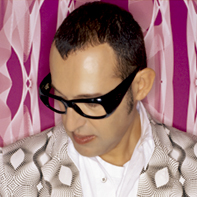14 Abr Karim Rashid: Design new role
 Today, industrial designers approach their work from a different perspective. A poetic design of products has evolved based on a plethora of complex criteria — human experience; social, global, economic and political issues; physical and mental interaction, form, vision, and a rigorous understanding of contemporary culture.
Today, industrial designers approach their work from a different perspective. A poetic design of products has evolved based on a plethora of complex criteria — human experience; social, global, economic and political issues; physical and mental interaction, form, vision, and a rigorous understanding of contemporary culture.
However, manufacturing is based on another collective group of criteria: capital investment, market share, production ease, dissemination, growth, distribution, maintenance and service, performance, quality, ecological issues and sustainability. The combination of all of these components has come to shape our objects, inform our aesthetic, our physical culture, and our human experiences. These issues shape the business — its identity, its brand, and its value.
Industrial design today is changing, and the role of the designer is plagued by the pressure to conform to the knock-off marketplace, not being necessary in a knock-off marketplace, or by only being able to bring a level of involvement to the surface of objects. Instead of having an instrumental role, their involvement is often limited to the visual aspects of design. The political and social role of design has become apparent in the hyper-explosive period of the twenty-first century, the advent of a critical stance on and celebration of the object as an “immaterial” infinity. Traditional empoisons of design methodology and a globalization of the consumer product has brought an end to the modern language of the object. Yet the object has become an endless appropriation of its predecessor, a cloning of clones as we trade spiritual values for material values and originality for simulation. The design process is marking time with works that become the foundation for other works via the continuum of concept from subject.
Designers must be involved in the abecedarian stage of development. It is necessary that they play a rigorous role in the conception of ideas and in the definition the object’s value, performance, and intelligible existence. In turn, industrial design must become more visible in the media so that design may evolve from a marginal subject into a pedestrian interest and desire. Greater awareness creates the need for more design participation, and the result is a richer and more relevant commodity landscape. Here, design engages the three most important roles of successful business – quality, service and loyalty.
The banal discussion around the notion that form follows function is completely irrelevant when considering sophisticated products with complex subjects, digital components, and nearly mythological hyper-objects that engage little interaction, if any. So how do we shape these objects? We must return to the subject as the origin of discussion — a place to study meaning and myth. Inanimate objects do not have meaning — we project meaning onto objects. Design is the study of the subject that informs the objects. Form follows subject.
Subject is not always driven by necessity or function. Subject may be a philosophical position on contemporary culture or a tenet on a changing condition. It may be human experience, behavior, movement, cultural phenomena, medial flexibility, sustainability, variation, reconfigurability, immateriality, materiality, consumption, transparency, or digital production. The subject may be erroneously banal, for example, in the case of tooling modification. These issues constitute a language that deals with the subject rather than the object. This is the First Order of good design. To quote Immanuel Kant: “In a product of beautiful art, we must become conscious that it is art and not nature; but yet the purposiveness in its form must seem to be as free from all constraint of arbitrary rules as if it were a product of mere nature.”
In my opinion, the utopian condition exists in a world in which every object is so perfectly cyclic that we can consume without guilt — that we can perpetually have new objects in our lives, experience heightened pleasure, and enjoy a dynamic and forever-changing commodity landscape. We will not own anything, but rather borrow or lease the components of our physical world. Our lives will be layered with evanescent phenomena – each object will yield an experience, and each new thing will afford us an even greater experience. As the digital age becomes more seductive, our physical world will demand perpetual newness of stimulation, phenomenological unexpected behaviors and events, and a seamless reformation of beauty and change.
More: www.articulado.org

